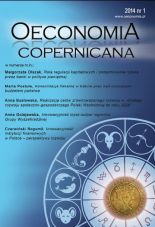Input-Output Innovativeness of the Visegrad Group Regions
Innowacyjność Input-Output regionów grupy wyszehradzkiej
Author(s): Anna GolejewskaSubject(s): Economy
Published by: Instytut Badań Gospodarczych
Keywords: innovation; regional input-output analysis
Summary/Abstract: Observation that regional factors could influence innovative capacity of firms caused interest growth of innovation analysis at regional level. The objective of the paper is to measure and compare INPUT and OUTPUT innovativeness of 35 NUTS-2 Visegrad Group (V4) regions in the years 2004-2009. The indexes of regional innovativeness are based on synthetic measure. The variables correspond with the variables proposed in Regional Innovation Scoreboard. The first part of the paper contains a survey of innovativeness measures. In the next part I apply INPUT-OUTPUT analysis. The research procedure consist of three steps. The construction of matrix of regional innovativeness data was the first step. The next step was the measurement of innovation indexes. The last step was the comparison of regions based on INPUT and OUTPUT indexes. The results show that there have been and continue to be substantial differences among the V4 regions as regards innovativeness. Differences are particularly visible in case of capital regions, which are characterised by the highest INPUT and OUTPUT indexes (except for mazowieckie). In 2009, high indexes have also 2 Czech regions: Strední Cechy and Jihovýchod. In the V4, high value of INPUT index not always corresponds to high value of OUTPUT index. The most numerous group consisted of regions with medium values of both indexes. The lowest OUTPUT indexes were recorded for Polish Eastern regions. To the group characterised by low or medium INPUT indexes and high OUTPUT indexes belonged mainly Czech and Hungarian regions. In Slovak regions low INPUT indexes corresponded to medium OUTPUT indexes. Analysing the results, one should not forget that they are based on seven variables, which are a resultant of – in some measure – random choice and data accessibility. However it should not underrate the importance of this research.
Journal: Oeconomia Copernicana
- Issue Year: 5/2014
- Issue No: 1
- Page Range: 61-78
- Page Count: 18
- Language: Polish

